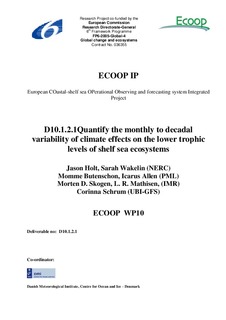| dc.contributor.author | Holt, Jason | |
| dc.contributor.author | Wakelin, Sarah | |
| dc.contributor.author | Butenschon, Momme | |
| dc.contributor.author | Allen, Icarus | |
| dc.contributor.author | Skogen, Morten D. | |
| dc.contributor.author | Mathisen, L. R. | |
| dc.contributor.author | Schrum, Corinna | |
| dc.date.accessioned | 2010-11-18T14:10:30Z | |
| dc.date.available | 2010-11-18T14:10:30Z | |
| dc.date.issued | 2010-02 | |
| dc.identifier.uri | http://hdl.handle.net/11250/109515 | |
| dc.description | ECOOP WP10, Deliverable no: D10.1.2.1 | en_US |
| dc.description.abstract | This report describes three studies using multi-decadal simulations of regional coupled hydrodynamics ecosystem models. These models are used to investigate the relationship between lower trophic level marine ecosystems and biogeochemistry, and the physical environment.
The models considered here: POLCOMS-ERSEM Atlantic Margin Model run from 1960 to 2003 (NERC and PML) NORWECOM North Sea Model run from 1985-2006 (IMR) ECOSMO (UiB-GFI) North sea and Baltic Sea run 1980-2004 (UiB-GFI)
The POLCOMS-ERSEM model is validated using in-situ data from the world ocean data centre and analysed to investigate the potential long term changes in primary production across the period 1960-2004, in the context of model open boundary conditions and drift. The model experiments demonstrate a strong sensitivity of the on-shelf primary production to the oceanic nutrient boundary conditions, suggesting cross-shelf edge nutrient fluxes provide a significant source of variability. The relationship between the model results and the North Atlantic Oscillation are also considered, demonstrating a r~0.65 correlation with on-shelf nutrients and the NAO
The NORWECOM model is validated here using time series data from the Dutch coast. Correlations between model variables in a selection of ICES boxes are compared with a number of driving factors. River loads are shown to dominate coastal boxes. The relationships in open-shelf boxes are more ambiguous, although the southerly inflow is demonstrated to have an important role. The validation of the POLCOMS-ERSEM and NORWECOM models both conclude that the simulations have better skill for nutrients than chlorophyll and in open-shelf seas away from the coast.
The validation of ECOSMO presented here focuses on zooplankton and comparison with data from the continuous plankton recorder, investigating six different approaches to matching CPR records with model data. Across the North Sea the mean annual cycle shows good agreement between model and CPR. There is also good correlation with along-track variability. EOF and correlation analysis is used to relate the primary production in the North Sea to atmospheric forcing parameters. The EOF patterns tend to match the distribution of summer time stratification, while the wind speed is shows the highest correlation, particularly during the onset and breakdown of stratification. This indicates the strength of cross-thermocline mixing is an important control on primary production variability. The ECOSMO model has been further developed for use in the Baltic by inclusion of nitrogen fixing cyanobacteria.
These studies each demonstrate significant control of the inter-annual variability of shelf sea ecosystems through a range of external forcing vectors: oceanic through cross-shelf edge nutrient flux, terrestrial through variations in river nutrient loading, and atmospheric via the wind control of vertical mixing. Each of these vectors potentially mediates climatic variability and climate change. | en_US |
| dc.language.iso | eng | en_US |
| dc.publisher | Danish Meteorological Institute | en_US |
| dc.subject | hydrography | en_US |
| dc.subject | hydrografi | en_US |
| dc.subject | ecosystem models | en_US |
| dc.subject | økosystemmodeller | en_US |
| dc.subject | trophic interactions | en_US |
| dc.subject | trofiske interaksjoner | en_US |
| dc.title | Quantify the monthly to decadal variability of climate effects on the lower trophic levelse of shelf sea ecosystems | en_US |
| dc.type | Research report | en_US |
| dc.subject.nsi | VDP::Mathematics and natural science: 400::Zoology and botany: 480::Ecology: 488 | en_US |
| dc.subject.nsi | VDP::Mathematics and natural science: 400::Geosciences: 450::Oceanography: 452 | en_US |
| dc.subject.nsi | VDP::Mathematics and natural science: 400::Geosciences: 450::Hydrology: 454 | en_US |
| dc.source.pagenumber | 43 s. | en_US |
